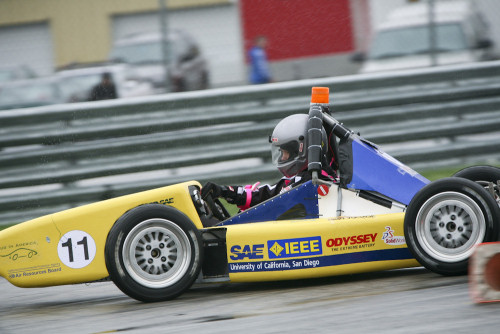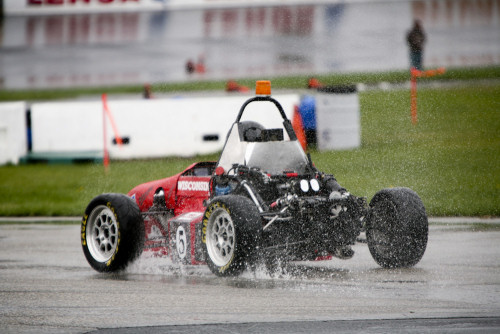The Way It Is/ Learning about Formula Hybrid
by Gordon Kirby This week from Monday through Wednesday I have the pleasure of serving as a member of the judging committee at the 6th annual Formula Hybrid International Competition at New Hampshire Motor Speedway. The Formula Hybrid competition is organized by Doug Fraser who's been a member of the engineering staff at Dartmouth College's Thayer School of Engineering for thirty years. More than thirty entries are expected this year from universities around the country plus entries from Canada, Sweden and Taiwan while Chrysler and Ford have joined General Motors and Toyota as sponsors of this year's event.
This week from Monday through Wednesday I have the pleasure of serving as a member of the judging committee at the 6th annual Formula Hybrid International Competition at New Hampshire Motor Speedway. The Formula Hybrid competition is organized by Doug Fraser who's been a member of the engineering staff at Dartmouth College's Thayer School of Engineering for thirty years. More than thirty entries are expected this year from universities around the country plus entries from Canada, Sweden and Taiwan while Chrysler and Ford have joined General Motors and Toyota as sponsors of this year's event.
Prior to joining Dartmouth Fraser was a successful engine-builder for many SCCA racing categories and today he's an enthusiastic vintage racer. Fraser was hired by Dartmouth as a research engineer doing microprocessor applications in electronics. Later he worked on the solar-powered Tour de Sol contest before becoming the student advisor for Dartmouth's entry in the Formula SAE competition then starting Formula Hybrid in 2006.
After I made a quick visit to last year's Formula Hybrid event Doug asked if I would like to write some blogs about the contest for the series' website Formula-Hybrid.org and be a member of the judging panel at this year's event. I accepted happily and have written seven or eight blogs for Formula-Hybrid.org over the past four months. Starting Sunday I will spend the next few days prowling around the NHMS garage area looking at the assembled cars and teams and watching them in action.

© Formula Hybrid
"We talked and they allowed us to bring our hybrid to the Formula SAE competitions in 2005 and we did a demonstration run," Fraser explained. "They didn't allow us to enter it in the competition but they let us drive it and show people what it could do."
Although Formula SAE banned hybrids the Society of Automotive Engineers has been extremely helpful to Formula Hybrid and the SAE's New England region is a sponsor of this year's event.
"The SAE has been very supportive right from the beginning," Fraser says. "They sent us the source for the Formula SAE rules which we went through, tweaked a lot of details and modified it heavily. Originally, the Formula Hybrid rules were published as an addendum to the Formula SAE rules."
With Fraser's prodding the Thayer School decided in 2006 that it would start a separate Formula Hybrid competition. The trustees of Dartmouth College trademarked the Formula Hybrid name and logo and a conference was organized at the Thayer School. Included was the chairman of the Formula SAE rules committee, other members of the Formula SAE organizing group, some faculty advisors from Formula SAE teams, plus some representatives from the electrical engineering world, most notably the Institute of Electrical and Electronic Engineers (IEEE).
"There are many different hybrid configurations," Fraser notes. "The Formula Hybrid rules require that the vehicle has an internal combustion engine and an electric motor system as opposed to hydraulic accumulators, flywheels and fuel cells. The only devices that are approved for electric accumulators are batteries or capacitors and they have very different characteristics that can be used to advantage in different ways."
A significant change from the SAE rules was reducing Formula Hybrid's maximum engine size from the SAE's 600cc to 250cc. There's no minimum or maximum weight for Formula Hybrid. The cars must have four wheels and a minimum wheelbase of sixty inches.
"We have deliberately set up a minimum of rules because we want the students to be as creative as they can be," Fraser remarks.
Formula SAE requires a new frame every year but Formula Hybrid allows older chassis to run as long as they are safe. The chassis rules are largely unchanged from Formula SAE. The same chassis strength and impact attenuators are required plus SAE-spec driver protection for driver's suit, helmet and safety gear. But the electrical rules are very different.

© Formula Hybrid
The annual, four-part competition at New Hampshire Motor Speedway takes place over two days. It opens with the teams making a formal presentation of their car and theories to a board of engineers who ask probing questions to test the student's knowledge. This is followed by an engineering and design analysis. The initial presentation is worth 100 points in the competition's total of 1,000 points and the engineering and design segment is valued at 200 points.
Whenever possible the design judges are engineers from automotive companies who are working on hybrid systems and fully immersed in hybrids. The teams present their vehicles and will be surrounded by a group of engineers who thoroughly quiz the students' understanding of their work with very specific questions.
The design and engineering contest is followed by the on-track competition which consists of a pair of acceleration runs over 75 meters, an autocross, and a concluding 22 kilometer endurance test. The two acceleration runs carry 75 points apiece. The autocross is worth 150 points and the concluding endurance event is the big one, worth 400 points toward a maximum potential total of 1,000 points.
The acceleration runs must be completed in no more than ten seconds and one of the two acceleration runs has to be completed with electric-only power. If the car can't make it, the team doesn't qualify for the rest of the competition. The deciding endurance autocross event must be completed as quickly as possible without using more than 20 megajoules which is the equivalent of 2.3 liters of gasoline taking internal combustion engine efficiency into consideration.
"One of the main things that sets Formula Hybrid apart is the energy allocation," Fraser observed. "They're allocated 20 megajoules of energy to complete the 22 kilometer endurance event. If they run out they're out of the competition. A lot of teams run electric only for the autocross. If they're a series hybrid their final drive is all-electric but in many cases the electric motor is the more powerful of the two than the internal combustion engine."
All the teams start the event with the same amount of energy on board with their accumulator systems filled to capacity by plugging into one of New Hamshire Motor Speedway's garage wall outlets. They are then given just enough liquid fuel to round out the 20 megajoule limit.
"Some accumulator systems, particularly batteries, have a very high energy density," Fraser remarked. "They're capable of storing a lot of energy and the accumulator can get pretty close to 20 megajoules. As an extreme example, if a team were to arrive with an accumulator which is rated at a capacity of 20 megajoules they would not get any gasoline."

© Formula Hybrid
"It's a great technical challenge for the students to figure out that this is a race car," McDermott commented. "It's not an economy car. What are the requirements on the whole car and in particular on the electrical drivetrain for a race car? It's an interesting challenge and it's great for me because I get to play with neat toys and work with neat students and get paid for it."
Formula Hybrid provides plenty of motivation for many engineering students across the United States and around the world and has established itself as an ideal recruiting ground for the auto industry to find skilled and motivated electrical and hybrid engineers dedicated to improving the efficiency and performance of the automobile.
"If you look at the alumni from Tour de Sol and Formula Hybrid," comments Rob Wills chairman of F-Hybrid's electrical rules committee. "You'll find a lot of them are working in the car companies and the hybrid vehicle business. A lot of early Sol people have ended up working on hybrid vehicles and the same thing is happening with Formula Hybrid. That's all good. It's exactly what we wanted to see from the competition."
Make McDermott agrees with Wills about job recruiting by the automotive industry.
"We have a couple of guys this year who have offers from GM and I think they're going to accept those offers," McDermott said. "We have at least one candidate every year and some years two or three who go to work in the automobile industry. Every once in a while someone will go to the motorsports business. Brian Welling is a Texas A&M graduate who works for Chip Ganassi's team. He's the assistant engineer I believe on Scott Dixon's Indy car."
McDermott adds that just like in any form of motor racing the driver is the most important part of the equation for any F-Hybrid team.
"I really believe that the most important piece in the whole project is the nut behind the wheel," McDermott declares. "We want to get our car built and give our drivers some seat time to get the handling and the balance the way they want it and get familiar with the car so they can get the best out of it. If you've got a really good driver he can take an average car and win. But if you've got a really good car and a bad driver, you're going to be an also-ran. Like I say, the driver is the most important part of the whole equation"
McDermott emphasizes that driver feedback is more important than the ability to drive fast.
"Our driver started out racing go-karts when he was real young and he's raced Late Model stock cars on dirt," McDermott related. "He's real good at providing feedback about what the car's doing and that's really hard and really important. I really appreciate the drivers who can do that."
Next week I'll report on this week's competition and let you know who won, who looked good and what I learned.
Auto Racing ~ Gordon Kirby
Copyright 2011 ~ All Rights Reserved
Copyright 2011 ~ All Rights Reserved
Top of Page